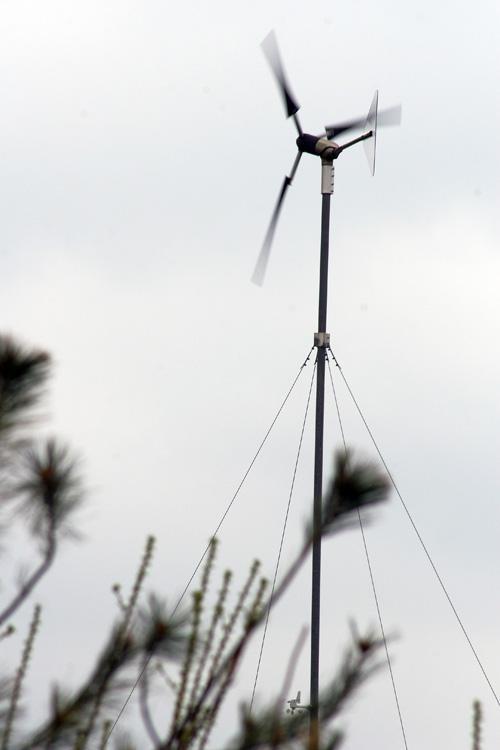Wind energy growing as a power source
Residential wind turbines are an alternative source of energy that can be used to help power homes. Erica Magda
May 2, 2008
Last updated on May 13, 2016 at 10:38 a.m.
Wind power is one of many options when it comes to finding alternative sources of energy. Some people are now able to power their homes through residential wind turbines, which not only saves electricity costs but can also benefit the environment.
Although wind energy only makes up for about 1 percent of the electricity used in the U.S., it is a growing industry and clean energy alternative, said Ron Stimmel, small wind advocate for the American Wind Energy Association.
Wind power can come in the form of large-scale wind farms or small residential wind turbines.
One of the closest wind farms to the Champaign-Urbana area is the Twin Groves farm owned by the Horizon Wind Energy company east of Bloomington, Ill. The farm has 240 turbines and can produce 396 megawatts of energy, said Marie Streenz, project coordinator for Horizon Winds.
Get The Daily Illini in your inbox!
The electricity from this wind farm is on the electricity grid and can power areas all the way from St. Louis to Pontiac, Ill., and southern areas of Chicago, Streenz said. Horizon Winds has at least a dozen other projects in various stages of planning around the state, she said.
“There is a lot of growth in wind energy right now,” Streenz said. “It actually has the capacity to be a much larger force than it is now, but it is not as widely used.”
Investing in renewable fuels can be costly and time consuming, but many states are making commitments to improving their efforts in this area.
“There is a lot going on with renewable fuels,” Streenz said. “People want to reduce our dependency on oil, and the environmental movement is growing stronger.”
Streenz added that many states, including Illinois, have implemented new renewable standards requiring a certain amount of energy to come from renewable sources. The standard in Illinois is that by 2025, the state aims to use 25 percent renewable energy, which can include wind energy.
People looking to use wind energy to power their homes can invest in a small, or residential, wind turbine.
Even turbines used in residential areas are very large pieces of equipment. They have rotors up to 23 feet in diameter, as tall as 120 feet and weighing up to 1,000 pounds, said Mike Bergey, president of Bergey Windpower Co.
Bergey Windpower is the nation’s oldest manufacturer of residential wind turbines and one of the leading suppliers.
“A lot of people like the environmental savings from a home wind system,” Bergey said. “If a homeowner installs a wind system, it is about the same as taking an SUV off the road.”
For people to be able to have a residential wind turbine, they need to have at least an acre of land, making these turbines not suitable for suburban homes and densely populated urban ares, Bergey said.
The major roadblock for people wanting to install residential turbines is cost. Powering a house can cost between $12,000 and $55,000, Stimmel said. While there are some individual grants to help people afford them, price is a problem, he added.
“Price is the number one barrier to people installing these turbines,” Stimmel said. “They are very expensive, and there is no federal-level subsidy for small wind.”
Prices are so high because turbines are such large pieces of equipment and have not yet been widely produced, Bergey said.
In spite of all of this, more people are installing these turbines to help with the alternative energy problem.
“The industry grew about 14 percent last year, and 10,000 small wind turbines were installed in that year alone,” Stimmel said. “They are really seamless, and the homeowner doesn’t have to do anything.”






